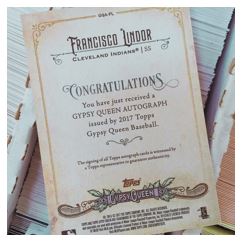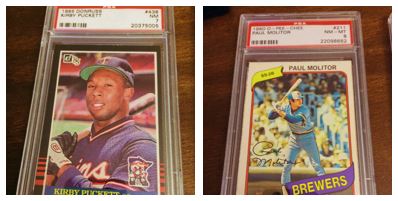There are plenty of companies out there that will authentic memorabilia and autographs and they are easy enough to find with a quick Google search. However, what you should know going in is that the authentication business is not without its faults and controversies. Authentication is not an exact science and even the best of these companies will tell you that their results are subjective and in the end an opinion.
Case in point, there have been instances of authenticators finding that an autograph is not genuine when the collector obtained the autograph in-person. In that type of situation there isn’t much you can do, but get a second opinion. You need to be prepared to be disappointed.
The only way to be sure about anything is to acquire the autograph in-person. Sometimes at bigger events authenticators may be available to do the work on the spot, but that’s not always the case.

Some of the autographs I’ve collected.
>>> READ MORE ABOUT COLLECTING AUTOGRAPHS THROUGH THE MAIL (TTM) <<<
>>> READ MORE ABOUT COLLECTING AUTOGRAPHS IN-PERSON <<<
What Do You Want from Authentication?
Authentication is a tricky business as I already said, but I can also tell you that it’s an expensive one. You need to start by deciding why you want to authenticate an item. Do you want to try to sell the item, be sure of what you have, or do you want to authenticate a piece you are passing down? These questions generate different pros and cons to consider.
As we’ll discuss below, the cost of authentication could change based on the fame of the person who gave the autograph. Yes, you could sell the item, but what will authenticating the item mean for your profit? Is the autograph from someone worth authenticating. The expense of authenticating might not mean much if you are only interested in collecting it and not getting rid of it.
That said, you can’t in good conscience get rid of an autograph that is not authenticated without telling the receiver that it’s not authenticated. Just make sure you are doing it for the right reasons.
The Process of Autograph Authentication
Every company that provides autograph authentication services will provide you with a list of tools and process they use to certify the autograph or item. They will explain their state-of-the-art exotransmogrifier is the top notch tool in the business. It’s all going to sound fancy to you. I’m not saying you can’t trust them, but don’t get caught up in the fanciest tools mean the best company.
No matter who certifies the autograph, they’ll use some or all of the following in the authentication process:
Ink Analysis
This step is looking to determine:
- Is the ink used consistent with ink used when the subject was alive?
- Is the ink performing as you would expect for its age? (i.e., absorption into object)
Object Analysis
This step depends on what the autograph is on. Is it a card? A bat? A helmet? No matter what the object it needs to be evaluated.
- Is the ink performing as you would expect over time given the object it’s on (especially paper)?
- Is the paper deteriorating as you would expect for its age?
- What damage is underneath or above the signature that might tell you when it was autographed?
Handwriting Analysis
This is really what you would think of from watching a “Law & Order” episode with a forensic handwriting expert.
- Are there stops or hesitations in the signature?
- What is the letter angle?
- What is the style and flow of the signature?
Signature Comparison
In this step the company is comparing to a known authenticated signature of the signer. Companies have libraries full of signatures ready to compare to.
Post-Evaluation Steps for Authentication
After the evaluation is complete and the autograph is deemed authentic, the companies continue with these steps:
Tagging
Tagging involves placing some form of tamper-resistant label on the object. This should have a serial number connected with it and then it would be logged into a database.
Certifying
A Letter of Authenticity or LOA is then included with the document. This will state who did the certifying and other related information. The tag will also be part of this document with the matching serial number.

An authentication message from the manufacturer
Additional Steps in Authentication
Some companies offer additional services. These could include Grading and/or Protection. Grading is the process by which a card for instance is branded with a score based on its quality. Protection is placing the item in a tamper proof case.

Graded cards (Not mine, though. Collected from an image search).
Companies Specializing in Autograph Authentication
As I stated earlier in this post, there are many of these companies out there and a simple Google search will allow you to find a lot. That said, the reputation of these companies are not all the same. No matter how reputable, they all can make mistakes and remember – it is not an exact science.
I would say that the most industry recognized names in the business are:
Professional Sports Authenticator (PSA/DNA)
James Spence Authentication (JSA)
Autograph Certification Experts (ACE)
There are some great companies out there that issue their own COAs that go with the autographed items they sell. These are witnessed by a company official. These include:
The Trouble of Authenicating Autographs
Authenticating Autographs is not without its problems. Before you decide to get an authentication done, you need to do your research. Research the company, the process, and the experiences of others. You’ll potentially be spending a lot of money and that doesn’t guarantee that you will have a happy result. Collecting autographs should be fun, and the more research you do will make you more comfortable about the decision you make if you decide to (or not to) follow through with authentication.
Thanks for visiting BravestarrCards.com: Card Collecting and TTM Autographs.
You should add Rackrs Authentication to the list. They are new but pretty good. https://rackrs.com/ is their website.
Thanks for the recommendation!